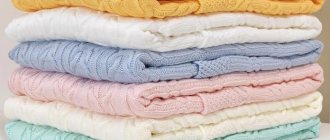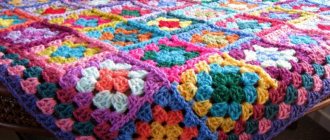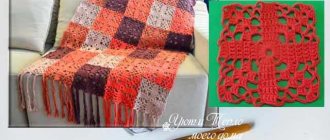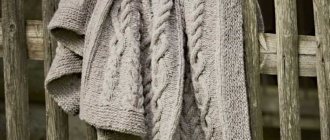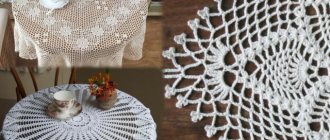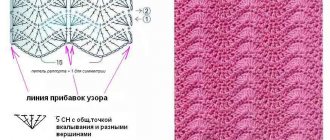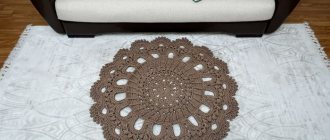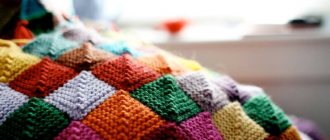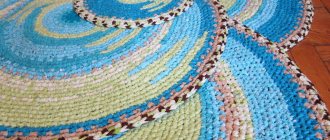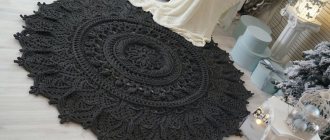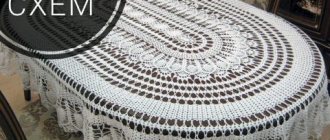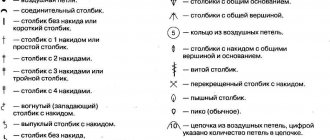For the second year in a row, chunky knitted blankets are filling the country’s Instagrams, and the trend for knitting in the interior has haunted me this fall.
I remember when I was studying at the Academy of Design and doing my homework about knitting as one of the trends, I was scrolling through pictures on Pintrest with blankets made from large yarn, but it didn’t even occur to me that you could knit these yourself. It seemed like these were some cool, inaccessible designer pieces.
But soon I began to come across posts on foreign blogs about hand knitting. Shtoa?! With your hands? So it is possible?
It turns out that yes. Very thick yarn is taken and hands are used instead of knitting needles.
Where to buy giant yarn
When I finished last year's fall reading nook project, I set about finding yarn. I searched on the Internet for “thick wool”, “giant plaid” and found strange groups that were engaged in joint purchases in Chinese stores. This didn't inspire confidence in me.
I wanted to trust the photographs, that in the end I would receive what is in the photo in my order, and I would order exactly the amount of yarn that is enough for a blanket of the right size. I reviewed so many sites that spring had already arrived and the project was postponed until autumn.
At the beginning of September, I found the Cozy Store website, which sells knitting yarn. This was what we needed! The store is in Moscow, but the parcel arrived in St. Petersburg in 3 days.
Options in the interior
Interior blankets are a unique accent in the design of different rooms:
- cozy living room;
- matrimonial bedroom;
- women's boudoir;
- guest room;
- children's "bedchamber".
Note! The huge advantage of hand-made products is that you can knit a whole set.
Under a knitted blanket from common yarn you can knit the following amazing beauty:
- rounded poufs;
- sofa cushions;
- chair covers;
- rugs under your feet.
Handmade interior knitwear has a unique charm. There are simple patterns, but they are difficult to copy, descriptions are needed. The beauty of many crochet motifs is difficult to replicate without a pattern - this is a great advantage of exclusive samples.
Handmade luxury
How much yarn do you need for a blanket?
Ooooh, that was the hardest question. I tormented the search engine with this question and for a long time could not find a normal answer. Everything was terribly confusing. Somewhere yarn was measured by weight, somewhere in meters, somewhere in balls. Mom dear!
I didn’t understand anything, I was terribly afraid that I would buy only enough yarn for a blanket for photo shoots - it turns out that on beautiful layouts on Instagram they often use not a full-fledged blanket, but a fake piece of a small blanket, especially for photo shoots - or I would buy so much of it that instead there will be a rug and a carpet.
As a result, I finally figured it out with the “Cozy Store”.
Here are the sizes and required amount of yarn:
- Blanket 80x120 cm – 2 kg
- Blanket 100x150 cm – 3 kg
- Blanket 130x170 cm – 4.5 kg
- Blanket 150x200 cm – 6 kg
For a medium-sized blanket, 3 kilograms of yarn were needed.
All the yarn was in one ball, so I didn't have to tie it and hide the knots while knitting. This volume of yarn produced a blanket measuring 100 by 135 cm (I measured it with a ruler!).
This is exactly what was needed. It's decorative, so I place it at the foot of the bed.
The choice of yarn depending on the chosen knitting technique
Experienced craftswomen choose yarn, focusing primarily on the technology for creating a particular model.
Patchwork is a technology for assembling a single fabric from scraps. In the case of knitted blankets, individual related motifs are used, connected to each other. Skilled needlewomen use remnants of thread from past projects.
The motives for the plaid are varied. The entire blanket can be created from threads of one, two or several colors. All the pieces can be the same or completely different - it depends only on the imagination of the master and the desired result.
Both fine and medium-sized yarn are suitable for knitting prefabricated patterns. The main rule when choosing is that all threads must be the same thickness. It is also important to remember that the thicker the thread, the rougher the pattern. Thick thread makes the blanket very heavy and makes the job of sewing the pieces together more difficult.
Bavarian knitting is a technique of crocheting a single fabric from air loops. A distinctive feature is knitting small circles without breaking the thread. By combining different colors with each other, you can achieve very interesting and original designs.
For knitting in this technique, it is best to use thin and medium wool threads. And, if you decide to knit a blanket from multi-colored yarns, you need to choose threads of the same thickness.
The Scandinavian method (double-sided jacquard) is a rather complex type of knitting. The peculiarity of this technique is in the drawing. The blanket is knitted from two threads of different colors. As a result, the chosen motif is clearly visible from both the front and back sides.
This technique can be worked using any type of yarn. Alpaca, merino, and angora rabbit wool are excellent. Blankets knitted from plush yarn look very beautiful.
Openwork and lace blankets are valued for their extraordinary beauty of execution and airy structure. Of course, such work requires a lot of effort, because the perfect pattern is created thanks to the endless patience of the craftswoman. But the result certainly pleases both the needlewoman herself and everyone around her.
There are a huge number of patterns for knitting lace motifs indicating the specific yarn for a particular pattern. The thinnest blankets are made from natural materials, synthetic threads or mixed yarns. You can create lace from thin wool, acrylic and viscose.
The thickness of the yarn may vary depending on the chosen blanket model. Here it is important to take into account one single rule: the tighter the thread is twisted, the clearer the pattern will be. Down lace is a completely different type of openwork; the motif of the design is not clearly visible, but can only be guessed on the canvas, covered with a continuous veil of down.
How to knit a blanket
I tried to remember the last time I knitted. The mind wandered and got lost in the memories of high school.
I figured that knitting was a skill like riding a bike—you’ll remember it when you need it—and I started looking for instructions on hand knitting. Of what I watched, I liked the Apartment Therapy video the most. No giant knitting needles made of plastic pipes (yes, yes, there is such a thing), no jewelry knitting patterns with your fingers and, most importantly, no instructions for an hour in a boring voice.
It took me watching the video more than once, with pauses and sometimes at slow speed, but these instructions worked.
Initially, I cast on 16 loops on my hand and, yes, my hand was enough. As a result, 16 loops gave the blanket a width of about a meter.
Colors
As a rule, there is no disagreement with the choice of color. Whatever yarn is available in the house is what they work with. When knitted from leftovers. then what is important here is the combination of shades and their overall balance. It is better when dark shades predominate in winter products, light shades in summer capes.
Important! For a baby blanket, you should not use too bright colors, they will irritate the baby.
When you want something new and very beautiful for an interior product, it is better to take milk instead of white, it’s more practical. It is better to replace black with purple, chocolate or dark blue. unless it is a priority color in the interior.
Calm, non-spectral colors, all shades of chocolate, as well as gray, beige and caramel tones are considered universal.
Luxurious gray interior bedspread
How long to knit by time
I knitted the blanket in two batches and spent 1.5 hours on the whole project. This also takes into account the fact that I had to photograph the process. If I didn’t want to share this story on the blog, then I would climb onto the sofa in the evening with a ball of yarn, light candles and knit a blanket in one movie and one evening. Here I am a little jealous of those who don’t have a blog and don’t have to take photos in the process.
Watch the video of how I knitted a blanket.
The finished blanket turned out very beautiful. And this despite the fact that I managed to mess up the knitting a little, forgot to slip off the first loop and, as a result, I couldn’t make a beautiful braid along the edge. If you are not so good at knitting, then you definitely won’t make such an annoying mistake. Well, I’ve warned you now, just in case!
Plus, it's super warm. While I was knitting, the blanket became longer and longer and began to cover my legs. So, I was hot while I was knitting.
Some designs are beautiful, but not very functional. I just knitted the blanket, but I’ve already spent several wonderful evenings under it. There is a risk that I will stop getting out from under the blanket and out of the house, how cozy, warm and pleasant it is.
Another unexpected bonus: when you finally get out from under the blanket, the folded corner looks mega-photogenic. No special fancy layouts are needed. The blanket is voluminous, so it looks very solid. Beautiful photos on Instagram are guaranteed.
Advantages and disadvantages
Few interior elements so harmoniously combine functionality and spectacular appearance. A hand-knitted blanket is also an exclusive detail that will tell others about your sense of style and handicraft skills. The canvas is valued by designers for its versatility, and is usually used as a decorative element:
- Balances the color palette of the interior as a whole.
- It has a “revitalizing” effect on boring upholstered furniture.
- In the bedroom it serves as an effective accent in a suitable color.
- It just complements the overall picture.
It’s hard to find a more functional item: you can cover yourself with a blanket during an afternoon rest, or use it instead of a warm sweater for a comfortable time in your favorite chair with a cup of coffee. Finally, if the blanket is made of natural wool, do not forget about the healing properties of this material.
Another advantage is the ability of knitted fabric to take almost any shape. The blanket can be conveniently placed both in a stroller and on the driver’s seat, and every time it will “sit” as if it were knitted according to a pattern.
A large knit baby blanket can be used for a stroller or car seat.
The disadvantages of such an accessory include the possibility of causing allergies (cases are not frequent, but they do occur), the ability to accumulate dust and the need for delicate care. And it’s no secret that knitwear (both large knit and not so much) are very demanding items to care for. However, true fans of such textiles are confident that a lot of advantages outweigh the disadvantages.
In any case, if you want to extend the life of such an accessory, it is important to remember that knitted blankets need gentle handling.
Another trouble is the pellets. Unfortunately, knitted blankets do not retain their original smoothness for very long.
